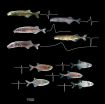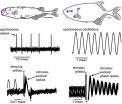(Press-News.org) The more than 200 species in the family Mormyridae communicate with one another in a way completely alien to our species: by means of electric discharges generated by an organ in their tails.
In a 2011 article in Science that described a group of mormyrids able to perceive subtle variations in the waveform of electric signals, Washington University in St. Louis biologist Bruce Carlson, PhD, noted that another group of mormyrids are much less discriminating (see illustration).
The fish with nuanced signal discrimination can glean a stunning amount of information from electric signals, including the signaler's species, sex, age, relative dominance status, and possibly even individual identity. They can also detect emotional states, such as aggression, submission, courtship and active exploration (see video below).
The fish with the simpler communication system were less studied and less well understood.
In the August 4 issues of the online journal eLife, Carlson and graduate student Christa Baker describe how they discovered the basis for the perceptual differences between the two groups of fish by studying the fish's sensory receptors.
"There had to be a neural correlate for the perceptual differences, so we looked to see if something was happening 'out in the periphery' where the signals are originally detected and encoded for processing in the brain," Carlson said.
The receptors in the less discriminating fish encode signals very differently than do the receptors in the more discriminating fish. Further, the receptors of the less discriminating fish are tuned to the collective signals from schools or shoals of fish rather than to those from individual fish.
"As far as we know, this is the first time anyone has found a receptor tuned to group communication signals rather than those coming from individuals," Carlson said.
Spiking versus oscillating
Weakly electric fish have sensory receptors in their skin, called knollenorgans, that detect electric pulses from their neighboring fish. The receptors are broadly distributed over the bodies of the discriminating fish, but in the less discriminating fish they are grouped into three clusters, or rosettes, on both sides of the head.
"We knew from work in the 1960s that there were differences in the physiology, or electrical behavior, of the sensory receptors," Baker said. "The broadly distributed receptors fire spikes, or action potentials, whereas the clustered receptors produce oscillating potentials at a constant frequency."
"We learned that when the oscillating recepters receive an electric signal, they reset their oscillation to a particular point in the cycle," she said. "This phase reset briefly syncrhonizes the oscillations of different receptors."
"No one had ever described anything like this in a sensory system before," Carlson said. "This is the first sensory receptor we know of that encodes stimuli by resetting the phase of ongoing oscillations."
"We investigated how the phase reset varied with different stimuli," Baker said, "and we found that the oscillating receptors do not encode the same information as spiking receptors."
The spiking receptors, which fire a nerve impulse every time there is an upward or downward excursion in the signal, are very good at encoding precise timing cues in signaling waveforms. But oscillating receptors encode only the onset of the signal and its point of origin.
"Fish with oscillating receptors are not behaviorally sensitive to waveform variation at least in part because the precise timing cues are not encoded by their receptors," Baker said.
Group think
So why do the fish with oscillating receptors bother to signal at all? What information do their receptors provide? The answer emerged when the scientists looked at how the receptors are tuned.
The spiking receptors are maximally sensitive to frequencies near those that make up the signals from other members of their species. The oscillating receptors, however, are tuned to much lower frequencies than those that characterize signals from their fellow fish.
"We found that the timing patterns they were most sensitive to were patterns that can only be produced by the collective signaling of large groups of fish," Baker said. "We think that the oscillating receptors help fish detect and locate those groups."
But why are these two groups of fish so different? "Our best guess is that differences in social behavior, in social organization, selected for differences in sensory capacities," Carlson said.
"Based on what I've seen in the field," he said, "the fish able to perceive small differences in the communication signals tend to be solitary and territorial, whereas the fish whose receptors are tuned to group signals tend to be more gregarious.
"My guess is that these two different lifestyles place very different selective pressures on communication. If you're solitary and territorial and you detect another fish in the area, you want to know exactly who that fish is. Is it a potential competitor, a potential mate, or a different species you're not worried about?
"On the other hand, if you're living in a shoal or school of fish, it's not so important to identify individuals. Just sticking with the group is going to be a successful strategy."
INFORMATION:
Cleaning up municipal and industrial wastewater can be dirty business, but engineers at the University of Colorado Boulder have developed an innovative wastewater treatment process that not only mitigates carbon dioxide (CO2) emissions, but actively captures greenhouse gases as well.
The treatment method, known as Microbial Electrolytic Carbon Capture (MECC), purifies wastewater in an environmentally-friendly fashion by using an electrochemical reaction that absorbs more CO2 than it releases while creating renewable energy in the process.
"This energy-positive, carbon-negative ...
(BOSTON) - Super productive factories of the future could employ fleets of genetically engineered bacterial cells, such as common E. coli, to produce valuable chemical commodities in an environmentally friendly way. By leveraging their natural metabolic processes, bacteria could be re-programmed to convert readily available sources of natural energy into pharmaceuticals, plastics and fuel products.
"The basic idea is that we want to accelerate evolution to make awesome amounts of valuable chemicals," said Wyss Core Faculty member George Church, Ph.D., who is a pioneer ...
Some neutron stars may rival black holes in their ability to accelerate powerful jets of material to nearly the speed of light, astronomers using the Karl G. Jansky Very Large Array (VLA) have discovered.
"It's surprising, and it tells us that something we hadn't previously suspected must be going on in some systems that include a neutron star and a more-normal companion star," said Adam Deller, of ASTRON, the Netherlands Institute for Radio Astronomy.
Black holes and neutron stars are respectively the densest and second most dense forms of matter known in the Universe. ...
From an early age, human infants are able to produce vocalisations in a wide range of emotional states and situations - an ability felt to be one of the factors required for the development of language. Researchers have found that wild bonobos (our closest living relatives) are able to vocalize in a similar manner. Their findings challenge how we think about the evolution of communication and potentially move the dividing line between humans and other apes.
Animal vocalisations are usually made in relatively narrow behavioural contexts linked to emotional states, such ...
Washington, DC-- Climate change caused by greenhouse gas emissions will alter the way that Americans heat and cool their homes. By the end of this century, the number of days each year that heating and air conditioning are used will decrease in the Northern states, as winters get warmer, and increase in Southern states, as summers get hotter, according to a new study from a high school student, Yana Petri, working with Carnegie's Ken Caldeira. It is published by Scientific Reports.
"Changes in outdoor temperatures have a substantial impact on energy use inside," Caldeira ...
A team of scientists believe they have shown that memories are more robust than we thought and have identified the process in the brain, which could help rescue lost memories or bury bad memories, and pave the way for new drugs and treatment for people with memory problems.
Published in the journal Nature Communications a team of scientists from Cardiff University found that reminders could reverse the amnesia caused by methods previously thought to produce total memory loss in rats. .
"Previous research in this area found that when you recall a memory it is sensitive ...
Dogs have a specialized region in their brains for processing faces, a new study finds. PeerJ is publishing the research, which provides the first evidence for a face-selective region in the temporal cortex of dogs.
"Our findings show that dogs have an innate way to process faces in their brains, a quality that has previously only been well-documented in humans and other primates," says Gregory Berns, a neuroscientist at Emory University and the senior author of the study.
Having neural machinery dedicated to face processing suggests that this ability is hard-wired ...
Trauma may cause distinct and long-lasting effects even in people who do not develop PTSD (post-traumatic stress disorder), according to research by scientists working at the University of Oxford's Department of Psychiatry. It is already known that stress affects brain function and may lead to PTSD, but until now the underlying brain networks have proven elusive.
Led by Prof Morten Kringelbach, the Oxford team's systematic meta-analysis of all brain research on PTSD is published in the journal Neuroscience and Biobehavioural Reviews. The research is part of a larger ...
CHARLOTTESVILLE, VA (AUGUST 4, 2015). Researchers at the University of Virginia (UVa) examined the number and severity of subconcussive head impacts sustained by college football players over an entire season during practices and games. The researchers found that the number of head impacts varied depending on the intensity of the activity. Findings in this case are reported and discussed in "Practice type effects on head impact in collegiate football," by Bryson B. Reynolds and colleagues, published today online, ahead of print, in the Journal of Neurosurgery.
The researchers ...
August 4, 2015 -- Treating maternal psychiatric disorder with commonly used antidepressants is associated with a lower risk of certain pregnancy complications including preterm birth and delivery by Caesarean section, according to researchers at Columbia University's Mailman School of Public Health, Columbia University Medical Center, and the New York State Psychiatric Institute. However, the medications -- selective serotonin reuptake inhibitors, or SSRIs -- resulted in an increased risk of neonatal problems. Findings are published online in the American Journal of Psychiatry.
"To ...




